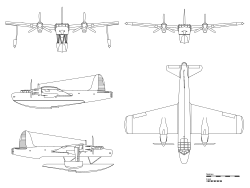Blackburn B.20
| Blackburn B.20 | |
|---|---|
| Type: | Experimental flying boat |
| Design country: | |
| Manufacturer: | |
| First flight: |
March 1940 |
| Number of pieces: |
1 |
The Blackburn B.20 was a British experimental aircraft and flying boat from 1940.
construction
The B.20 was designed in such a way that its floats could be pulled to the hull after take-off and extended again for landing. This should reduce the aerodynamically unfavorable properties of swimmers. This kind of improvement in aerodynamics could be Blackburn's patented chief designer.
The concept was intended to solve several problems; the first was to avoid splashing water, which would affect the engines and propeller performance when launched. Second, the retraction of the swimmers should reduce the attack surface of the flying boat. In addition, the aerodynamics were improved in flight.
The first flight took place at the end of March 1940. However, on April 7, 1940 there was a crash during a high-speed test. Three of the five-man crew died in the accident. As a result, work on the B.20 was stopped.
Technical specifications
| Parameter | Data |
|---|---|
| crew | 6th |
| length | 21.2 m |
| span | 25 m |
| height | 7.65 m |
| Wing area | 99 m² |
| Empty mass | k. A. |
| Takeoff mass | 15,900 kg |
| drive | two Rolls-Royce Vulture 24-cylinder X-type with 1,720 PS each (approx. 1,270 kW) |
| Top speed (estimated) |
490 km / h at an altitude of 4,575 m |
| Cruising speed | 322 km / h |
| Service ceiling | k. A. |
| Range (estimated) | 2,400 km |
| Armament (planned) | eight 7.7 mm Vickers machine guns and four 227 kg bombs |
See also
literature
- Jane's, The Blackburn B. 20 , 107

